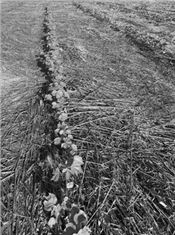|
July 25 Field Day To Feature Healthy Soils, Sustainable Cotton

Cotton coming up in rolled cover crop on Adam Chappell’s farm in Cotton Plant, Arkansas.
U of A System Division of Agriculture photo by Bill Robertson
LITTLE ROCK, ARK.
Two farmer-mentors, specialists from the University of Arkansas System Division of Agriculture and the Soil Health Institute will be guiding growers on July 25 through demonstrations and discussions of ways to improve soil health on Arkansas cotton farms.
The Healthy Soils for Sustainable Cotton Farm Field Day in Arkansas will start at 8 a.m. at the Brinkley Convention Center, 1501 Weatherby Drive in Brinkley.
Participants are asked to register by July 19 to ensure a lunch count. Register by calling Debbie Moreland, 501-425-2891. There is no cost to attend.
“Growers will learn what ‘soil health’ is and the indicators used to measure it,” said Matt Fryer, extension soil health instructor with the Division of Agriculture. “They will also learn what equipment is needed, what cover crop mix to plant based on the following cash crop and desired goals, cover crop planting methods, and the obstacles to overcome when planting a cash crop into cover crop residue.
“Most importantly, growers will hear the lessons learned from two Arkansas producers with a combined 18 years of cover cropping experience,” he said.
The two farmer-mentors are Adam Chappell of Cotton Plant, and Robby Bevis of Lonoke. Adding to the discussion will be three Division of Agriculture staff and faculty, Fryer, Bill Robertson, extension cotton agronomist and Trent Roberts, associate professor in Crop, Soils and Environmental Sciences, and David Lamm of the Soil Health Institute.
Animal ag and healthy soils
Robertson will be talk about how animals fit into the picture of healthy soils – something that’s not often discussed.
“The discussion around the grazing will concentrate on species selection,” he said. “We plan to have one animal unit of cattle and sheep on display,” he said. “We’ll discuss the pros and cons of each, fencing requirements, and potential for marketing.
“The livestock must also be profitable for this to work,” Robertson said. “Adam had good success with cattle last year and is wanting to use sheep this year.”
The agenda:
• 8 a.m. – Welcome and bus trip over to Chappell’s Farm.
• 9 a.m.-9:30 a.m. – Overview of soil health management system
• 930-11 a.m. – Concurrent demonstrations;
Chappell – Adapting Equipment for Soil Heath;
Robertson – Cover Crops used in Cotton Systems.
Lamm – Linking Soil Biology to Soil Health
• 11 a.m.-1 p.m. Lunch and travel to Bevis Farm in Lonoke.
• 1 p.m.-2 p.m. – Bevis – Overview of Soil Health Management System.
• 2 p.m.-3:30 p.m. – Fryer and Roberts – Cover Cropping with a Purpose
• 3:30 p.m. – Return to convention center, discussion. ∆
|
|